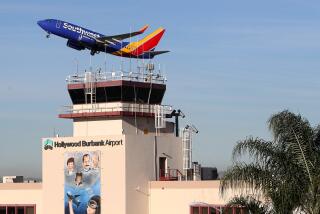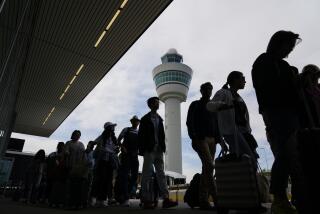CROWDED SKIES OVER THE PACIFIC : Asia’s airlines will need to double their fleets to meet passenger demand by 2000. But that can’t happen unless airspace and airport congestion is alleviated.
LONDON — Airport congestion in Asia has been greatly underestimated in many forecasts of air traffic to the year 2000 and is likely to be the biggest obstacle to airline growth, according to a study of regional air traffic.
While worldwide supply of wide-bodied aircraft must grow 45% during the period to meet demand, Asia’s airlines will need to double their fleets if they are to accommodate the region’s growth and the recently acquired passion in Japan for foreign travel. But such growth will not be possible unless the problems of airspace and airport congestion are addressed.
The study was compiled by the Manila-based Orient Airline Assn., which represents 14 regional airlines, including Japan Air Lines, Qantas, All Nippon, Cathay Pacific, Thai, Korean Air and Philippine Airlines, which together accounted for 40% of the world airline operating profits in 1988. It draws on studies from member airlines, the regional airports and projections from Boeing, Airbus Industries and McDonnell Douglas.
It confirms that the biggest bottlenecks are likely to remain Tokyo’s Narita, Hong Kong’s Kaitak and Sydney’s Kingsford Smith airports and the airspace in general around Japan. These airport authorities respectively forecast 7%, 5.7% and 8% annual growth in passenger departures by 2000. Actual growth rates in 1988, however, were 27.1% for Narita, 20.4% for Kaitak and 15.7% for Sydney.
Even given what the Orient Airline Assn. calls these “low to medium scenario” growth patterns, Osaka and Narita airports will handle more than 24 million departures by the year 2000, compared to 9.5 million in 1988; Kaitak 16 million, compared to 7.7 million, and Sydney 37 million domestic and international departures, compared to 13.3 million in 1988.
Much More Cargo
A more realistic scenario, according to the Orient Airline Assn. study, is a 9% to 9.5% annual growth in passenger traffic for the region as a whole--even after taking into account some loss of momentum as a result of the economic and political turmoil in China. This translates into about 185 million departures a year at the turn of the new century, compared to 66.5 million in 1988.
Cargo freight, handling of which is not considered such a problem by most airport authorities, will grow at most to 14 million tons from 3.3 million tons a year by 2000.
Current airline expansion plans will not, according to the Orient Airline Assn., meet these demand projections. Michael Hewitt, the OAA secretary-general, believes that new orders will increase until 1992 and that as many as 100 more wide-bodied aircraft will be ordered regionally in addition to orders already placed. The OAA members have 583 aircraft, two-thirds of which are already wide-bodied designs.
Some of the current airport congestion problems are being addressed. The Australian government has decided, subject to an environmental impact study, to build an extra runway at Kingsford Smith. The downside of this hard-won victory for planners is that a decision to build what is the long-term solution, a new airport, may now be further off.
In Hong Kong, the governor will announce in October the location of a new airport--probably at Chek Lap Kok--which will be completed by 1997. Extra aprons are planned at Kaitak, but estimates suggest that the recently expanded airport will still reach capacity by 1992.
In Tokyo, what should have been the second half of the Narita airport complex remains unbuilt amid continued resistance from a handful of Japanese farmers and persistent harassment of officials by environmental pressure groups. Pushing Honeida into Tokyo Bay mainly for domestic traffic will help only partly. Development of Kansei, a new airport in Osaka Bay, may be more beneficial when it comes into operation in 1993.
Restrictions Hurt
Some hope is also offered by more advanced aircraft technology as more longer haul jets from the United States are able to fly past Tokyo to other Asian capitals. This will allow U.S. airlines such as American, Continental and Delta to develop the kind of “hub and spoke” operations from Kimpo airport in Seoul, South Korea, for example, that Northwest and United have successfully built out of Narita.
This could ease pressure on one of the most serious congestion points in the air corridor east of Narita through which many westbound transpacific flights must pass. But the real bottleneck around Japan is unlikely to be removed until Japan’s military lifts restrictions on civilian flights over the Sea of Japan, to the west of the archipelago.
Hewitt believes that less tangible pressures are developing on Asia’s airports. Deregulation and liberalization in the United States, developing in Europe and coming in some form next year to Australia, will not pass Asia by. In the wake of additional flexibility and perhaps less reliance on bilateral carrier arrangements will be cheaper fares and increased demand to travel.
The Orient Airline Assn. report offers no solutions other than that more hotels, airports and larger fleets need to be built to accommodate the region’s changing travel tastes. It implies, however, that if governments are to meet the challenge, they will have to debate historically prickly issues. They will have to raise the question again--in Sydney and Hong Kong, for example--of lifting night flying curfews, and they will have to combat the altogether tougher 15-year opposition to new facilities at Narita in Tokyo.
PASSENGER DEPARTURES TOKYO Narita airport
Forecast Actual for 2000 1988 7% growth 27% growth 24 million* 9.5 million
HONG KONG Kaitak airport
Forecast Actual for 2000 1988 5.7% growth 20.4% growth 16 million 7.7 million
SYDNEY Kingsford Smith airport
Forecast Actual for 2000 1988 8% growth 15.7% growth 37 million 13.3 million
More to Read
Sign up for Essential California
The most important California stories and recommendations in your inbox every morning.
You may occasionally receive promotional content from the Los Angeles Times.










